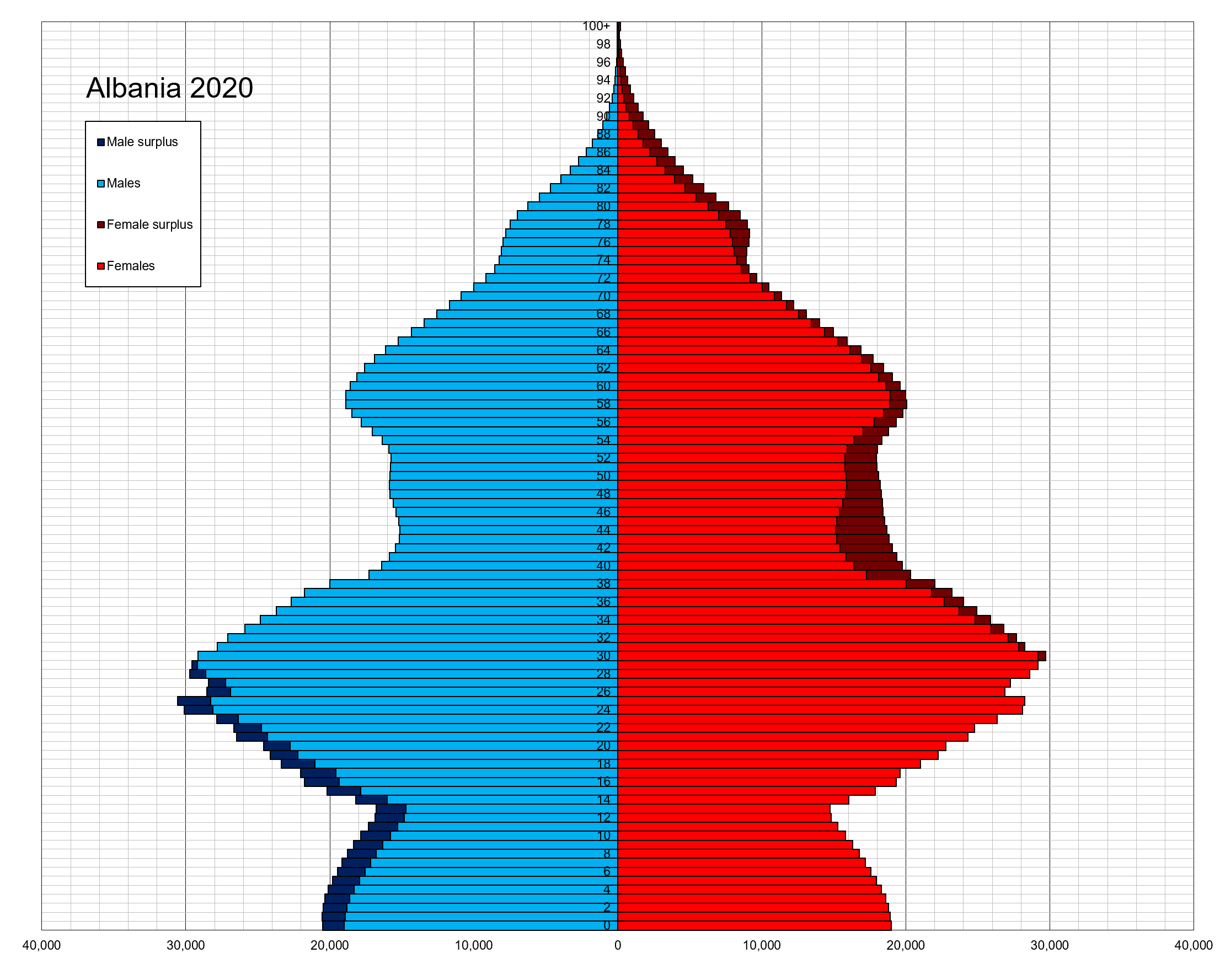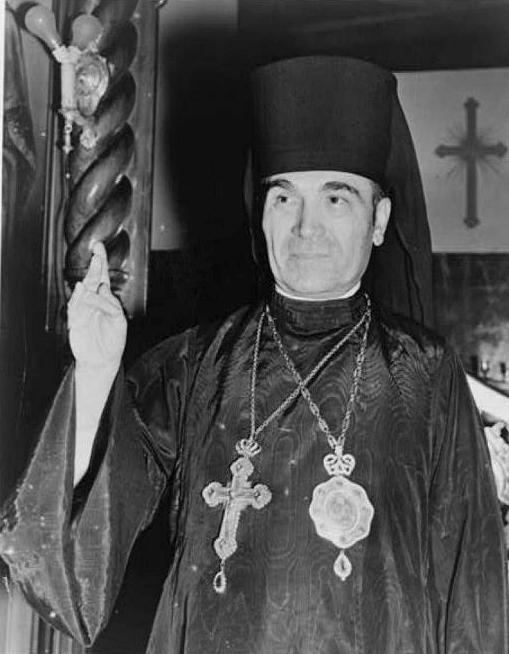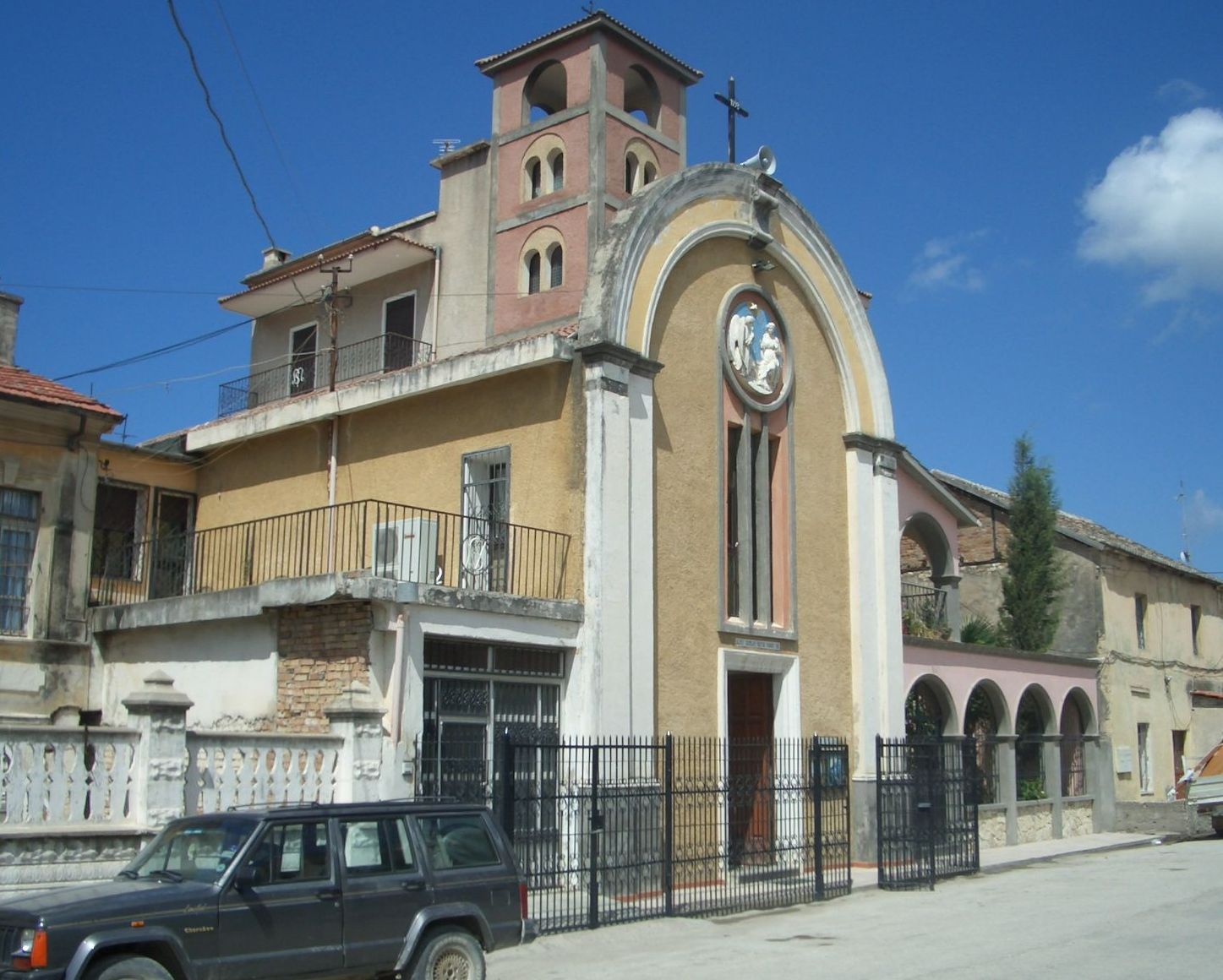|
Ethnic Groups In Albania
demography, Demographic features of the population of Albania include population density, ethnic group, ethnicity, education level, health of the populace, economic status, religious affiliations and other aspects. The demography of Albania is monitored by the Institute of Statistics (Albania), Institute of Statistics of Albania. The institute has performed demographic Census in Albania, censuses since the 1920s. The latest census in Albania was performed in September 2023. Albania is a fairly ethnically and linguistically homogeneous country, with ethnic Albanians forming 91% of the total population in the country. The total population residing in Albania in September 2023 was 2,402,113 according to the most recent Institute of Statistics (Albania), INSTAT census. The population pyramid shown in the infobox on this page does not reflect this population census with figures of the birth cohorts deflated, sometimes drastically, and the population pyramid deflated with no large out ... [...More Info...] [...Related Items...] OR: [Wikipedia] [Google] [Baidu] |
Albania
Albania ( ; or ), officially the Republic of Albania (), is a country in Southeast Europe. It is located in the Balkans, on the Adriatic Sea, Adriatic and Ionian Seas within the Mediterranean Sea, and shares land borders with Montenegro to the northwest, Kosovo to the northeast, North Macedonia to the east and Greece to the south. With an area of , it has a varied range of climatic, geological, hydrological and morphological conditions. Albania's landscapes range from rugged snow-capped mountains in the Accursed Mountains, Albanian Alps and the Korab, Central Mountain Range, Albania#Skanderbeg Mountains, Skanderbeg, Pindus and Ceraunian Mountains, to fertile lowland plains extending from the Albanian Adriatic Sea Coast, Adriatic and Albanian Ionian Sea Coast, Ionian seacoasts. Tirana is the capital and largest city in the country, followed by Durrës, Vlorë, and Shkodër. Albania was inhabited by several List of Illyrian peoples and tribes, Illyrian tribes, among them the A ... [...More Info...] [...Related Items...] OR: [Wikipedia] [Google] [Baidu] |
Emigration
Emigration is the act of leaving a resident country or place of residence with the intent to settle elsewhere (to permanently leave a country). Conversely, immigration describes the movement of people into one country from another (to permanently move to a country). A migrant ''emigrates'' from their old country, and ''immigrates'' to their new country. Thus, both emigration and immigration describe International migration, migration, but from different countries' perspectives. Demographers examine push and pull factors for people to be pushed out of one place and attracted to another. There can be a desire to escape negative circumstances such as shortages of land or jobs, or unfair treatment. People can be pulled to the opportunities available elsewhere. Fleeing from oppressive conditions, being a refugee and Asylum seeker, seeking asylum to get Refugee#Refugee status, refugee status in a foreign country, may lead to permanent emigration. Forced displacement refers to group ... [...More Info...] [...Related Items...] OR: [Wikipedia] [Google] [Baidu] |
Atheism In Albania
Irreligion, atheism and agnosticism are present among Albanians (see religion in Albania), along with the predominant faiths of Islam and Christianity. The majority of Albanians lead a secular life and reject religious considerations to shape or condition their way of life. Irreligion in Albania arose after a period of rising anti-clericalism and secularization in the context of the rising Albanian nationalism in the late Ottoman Empire. While authors in this period had at times used invective against religion, the first public advocate of abandoning religion itself was Ismet Toto in 1934 followed by works by Anastas Plasari in 1935. Beginning in 1946 under communist rule in Albania, religion was first curtailed, and then public religious practice was outlawed in 1967 with the adoption of state atheism by Enver Hoxha although some private practice survived, and remained so until restrictions were first eased in 1985 and then removed in 1990 under his successor Ramiz Alia. Polli ... [...More Info...] [...Related Items...] OR: [Wikipedia] [Google] [Baidu] |
Protestants In Albania
Evangelical Protestantism is one of five officially recognized faiths in Albania. It is a Christian faith that views Jesus Christ as its founder and head, and the Bible (especially the New Testament) as its written authority. The US International Religious Freedom Report of 2022 noted that 38% of the population (just over a million people) have a Christian background. The number of Evangelical Protestants in Albania has risen from approximately 8000 in 1998, to approximately 14,000 in the early 2020s. However, in the 2011 census, 70% of respondents refused to declare belief in any of the listed faiths. Unlike other official religions in Albania, Evangelical Protestants are not organized under a hierarchy with an official head, but operate autonomously in separate churches or organizations bearing different denominational or non-denominational names. Most, but not all Evangelical/Protestant groups are members of the Albania's Evangelical Brotherhood (VUSH), a cooperative organiza ... [...More Info...] [...Related Items...] OR: [Wikipedia] [Google] [Baidu] |
Eastern Orthodoxy In Albania
Eastern Orthodoxy arrived in the areas of Illyrii proprie dicti or Principality of Arbanon during the period of Byzantine Empire. Those areas fell under the Ottoman Empire during the late medieval times and Eastern Orthodoxy underwent deep sociopolitical difficulties that lasted until the fall of the Ottoman Empire. Between 1913 and until the start of WWII under the newly recognized state of Albania, Eastern Orthodoxy saw a revival and in the 1937 the Autocephaly after a short Eastern Orthodoxy schism and contestation was recognized. Decades of persecution under the Communist state atheism, which started in 1967 and officially ended in December 1990, greatly weakened all religions and their practices especially Christians of Albania. The post-communist period and the lifting of legal and other government restrictions on religion allowed Orthodoxy to revive through institutions and enabled the development of new infrastructure, literature, educational facilities, international tra ... [...More Info...] [...Related Items...] OR: [Wikipedia] [Google] [Baidu] |
Roman Catholicism In Albania
The Catholic Church in Albania () is part of the worldwide Catholic Church, under the spiritual leadership of the Pope in Rome. At the 2023 census, the percentage of Catholics was 8.38%. Catholicism is strongest in the northwestern part of the country, which historically had the most readily available contact with, and support from, Rome and the Republic of Venice. Mirditë has the highest concentration of Catholics while, Shkodër is the center of Catholicism in Albania. More than 20,000 Albanian Catholics are located in Montenegro, mostly in Ulcinj, Bar, Podgorica, Tuzi, Gusinje and Plav. The region is considered part of the Malsia Highlander region of the seven Albanian Catholic tribes. The region was split from Ottoman Albania after the First Balkan War. There are also scattered Albanian Catholics in Kosovo and North Macedonia, with the greatest concentration being in the vicinity of Gjakova. There are five dioceses in the country, including two archdioceses plus an Ap ... [...More Info...] [...Related Items...] OR: [Wikipedia] [Google] [Baidu] |
Christianity In Albania
Christianity in Albania began when Christians arrived in Illyria soon after the time of Jesus, with a bishop being appointed in Dyrrhachium ( Epidamnus) in 58 AD. When the Roman Empire was divided in 395 AD, modern Albania became part of the Byzantine Empire, but was under the jurisdiction of the Pope until 732, when Emperor Leo III placed the church under the Patriarch of Constantinople. When the Christian church split in 1054, the north followed Rome while the south of the country stayed with Constantinople. From 1100 AD, the Roman Empire carried out Church missions in the area. In relation to the increasing influence of Venice, the Franciscans started to settle down in the area in the 13th century. From the 15th century to the 19th century, under the rule of the Ottoman Empire, Christianity was replaced by Islam as the majority religion in Albania. Demographics Census in 2011 The 2011 population census, gives the percentages of religious affiliations with 58% Muslim, 10% ... [...More Info...] [...Related Items...] OR: [Wikipedia] [Google] [Baidu] |
Islam In Albania
Islam arrived in Albania mainly during the Ottoman period in the history of Albania, Ottoman period when the majority of Albanians over time converted to Islam under Ottoman Empire, Ottoman rule. Following the Albanian National Awakening , Albanian National Awakening (Rilindja) tenets and the de-emphasis of religious tradition in Albania, all governments in the 20th century pursued a secularization policy, most aggressively under the People's Socialist Republic of Albania, which actively Persecution of Muslims, persecuted Muslims. Due to this policy, Islam, as with all other faiths in the country, underwent radical changes. Decades of state atheism, which ended in 1991, brought a decline in the religious practice of all traditions. The post-communist period and the lifting of legal and other government restrictions on religion allowed Islam to revive through institutions that generated new infrastructure, literature, educational facilities, international transnational links a ... [...More Info...] [...Related Items...] OR: [Wikipedia] [Google] [Baidu] |
English Language
English is a West Germanic language that developed in early medieval England and has since become a English as a lingua franca, global lingua franca. The namesake of the language is the Angles (tribe), Angles, one of the Germanic peoples that Anglo-Saxon settlement of Britain, migrated to Britain after its End of Roman rule in Britain, Roman occupiers left. English is the list of languages by total number of speakers, most spoken language in the world, primarily due to the global influences of the former British Empire (succeeded by the Commonwealth of Nations) and the United States. English is the list of languages by number of native speakers, third-most spoken native language, after Mandarin Chinese and Spanish language, Spanish; it is also the most widely learned second language in the world, with more second-language speakers than native speakers. English is either the official language or one of the official languages in list of countries and territories where English ... [...More Info...] [...Related Items...] OR: [Wikipedia] [Google] [Baidu] |
Italian Language
Italian (, , or , ) is a Romance language of the Indo-European language family. It evolved from the colloquial Latin of the Roman Empire. Italian is the least divergent language from Latin, together with Sardinian language, Sardinian. It is spoken by about 68 million people, including 64 million native speakers as of 2024. Italian is an official language in Languages of Italy, Italy, Languages of San Marino, San Marino, Languages of Switzerland, Switzerland (Ticino and the Grisons), and Languages of Vatican City, Vatican City; it has official Minority language, minority status in Minority languages of Croatia, Croatia, Slovene Istria, Romania, Bosnia and Herzegovina, and the municipalities of Santa Teresa, Espírito Santo, Santa Tereza, Encantado, Rio Grande do Sul, Encantado, and Venda Nova do Imigrante in Languages of Brazil#Language co-officialization, Brazil. Italian is also spoken by large Italian diaspora, immigrant and expatriate communities in the Americas and Austral ... [...More Info...] [...Related Items...] OR: [Wikipedia] [Google] [Baidu] |
Greek Language
Greek (, ; , ) is an Indo-European languages, Indo-European language, constituting an independent Hellenic languages, Hellenic branch within the Indo-European language family. It is native to Greece, Cyprus, Italy (in Calabria and Salento), southern Albania, and other regions of the Balkans, Caucasus, the Black Sea coast, Asia Minor, and the Eastern Mediterranean. It has the list of languages by first written accounts, longest documented history of any Indo-European language, spanning at least 3,400 years of written records. Its writing system is the Greek alphabet, which has been used for approximately 2,800 years; previously, Greek was recorded in writing systems such as Linear B and the Cypriot syllabary. The Greek language holds a very important place in the history of the Western world. Beginning with the epics of Homer, ancient Greek literature includes many works of lasting importance in the European canon. Greek is also the language in which many of the foundational texts ... [...More Info...] [...Related Items...] OR: [Wikipedia] [Google] [Baidu] |
French Language
French ( or ) is a Romance languages, Romance language of the Indo-European languages, Indo-European family. Like all other Romance languages, it descended from the Vulgar Latin of the Roman Empire. French evolved from Northern Old Gallo-Romance, a descendant of the Latin spoken in Northern Gaul. Its closest relatives are the other langues d'oïl—languages historically spoken in northern France and in southern Belgium, which French (Francien language, Francien) largely supplanted. It was also substratum (linguistics), influenced by native Celtic languages of Northern Roman Gaul and by the Germanic languages, Germanic Frankish language of the post-Roman Franks, Frankish invaders. As a result of French and Belgian colonialism from the 16th century onward, it was introduced to new territories in the Americas, Africa, and Asia, and numerous French-based creole languages, most notably Haitian Creole, were established. A French-speaking person or nation may be referred to as Fra ... [...More Info...] [...Related Items...] OR: [Wikipedia] [Google] [Baidu] |









